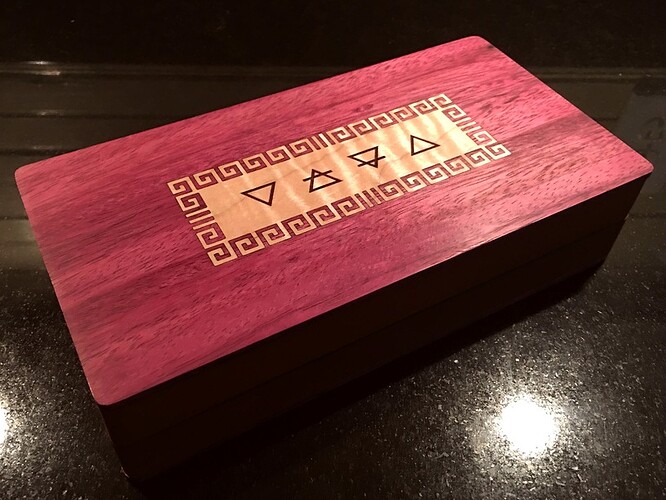Hello, my friends call me Box.
Purpleheart, Curly maple
This is a semi-clone of the recent layered box I posted here. That post is much more detailed and much of what I wrote there applies here.
Notes:
- Of course this wasn’t the exact same size as the previous box. That would have been too easy. As such I had to pretty much design this from scratch.
- The overall box dimensions are 7-7/8 x 3-15/16 x 1-13/16" ( 199 x 100 x 46 mm)
- I took advantage of that to change the divider/edge thickness to be 0.2" (5mm) instead of 0.15" (3.8mm). I felt like .15 was a bit too thin, both aesthetically and structurally.
- The inlay was much thinner and more fragile than the previous swirl design. Move slowly and carefully, it would be very easy to crack the greek key designs.
- The purpleheart had a lot of surface imperfections that ran really deep. It required a great deal of sanding, and as such was quite time consuming. I suppose I should buy a high quality orbital sander, mine stinks, so i do things by hand.
- All woods are 1/8", all exterior surfaces sanded to 2500 grit. In practice I don’t see a difference in surface quality past 1500, but here we are.
- Wood surfaces were finished with clear Danish oil.
The inlaid curly maple is eye-catching. It shimmers noticeably as you move around the box. The purpleheart is no slouch and has a nice bit of shimmer to it, but it’s hard to compete with the maple in that regard.
Purpleheart, Curly maple
The box is designed almost exactly like my last one, 4 magnet pairs all set the same direction, polarity-wise. The inner visible layers are hard maple, not curly. This was for two reasons: I didn’t have any more curly maple to use, and it’s just not as visible. Better to just use the more common and less expensive plain maple. Not pictured: the bottom surface is solid purpleheart.
Purpleheart, Curly maple, hard maple headliner fabric, Neodymium magnets
The edges are wrapped in cowhide leather this time. It was pre-finished, which saved me some steps compared to the last wrap job.
Purpleheart, Curly maple, cowhide
Like the previous box, this was also designed to fit a dice tray, both thematically and dimensionally. You can see the curly maple doing its thing on the dice tray, they really do complement each other very nicely. Oh also this may be the first time I posted pics of this dice tray, so… “Hi, I go by Tray.”
Purpleheart, Curly maple
Final thoughts:
If I did it again I would definitely steer clear of any woods with surface damage, the sanding was a drag and took far too long. It was just such a nice purple shade, my other purpleheart has gone a little brown… I couldn’t resist. But I paid for it.
Layered construction is always a little labor intensive, at least it is the way I do it – insisting on no visible registration dowels is fiddly. That being said, I think it is worth the effort to get the more refined end product. As a oneoff gift, yeah, do it this way. Trying to scale up for production? I wouldn’t recommend it.






